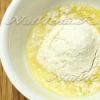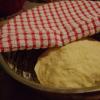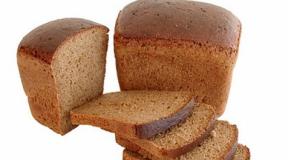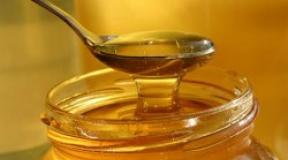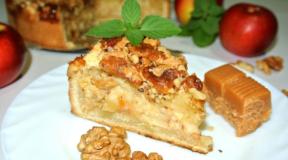Interesting serving of dishes in restaurants. Restaurant serving dishes: photo
Evgeny Veselov,
restaurant chef
Forte bello
The most simple serving dominates, the reason is banal - the desire to reduce the cost of the dish. If we talk about world trends, then now they often present the usual dishes in an unusual form, for example, pâté with tangerine jelly in the form of a tangerine. Of course, no one canceled the role of interesting author's tableware in serving, but here again we return to the question of cost price.
Yesterday in serving - all kinds of variations on the theme of decorating with a mix salad of shrimp, chicken fillet, etc.
I follow what surprises Rene Redzepi, Ferran Adria, Nobu Matsuhisa and other chefs in foreign restaurants, what kind of tableware appears on the market and what new equipment manufacturers offer.
Chefs draw ideas for new dishes from cookbooks and travel to other countries and cities, and sometimes a trip to the grocery market is enough for them

2. "Handwriting" of the chief
restaurant chef
"Searchlight"
Each chef has his own style, which he adheres to, or the author's vision of existing techniques. There are dishes for which classic white plates are enough, and there are those that need an original serving.
I really like what they do Grant Ashats and Rene Redzepi... In my opinion, a very interesting idea is the use of a 3D printer in working with chocolate.

3. Author's tableware
restaurant chef
"Latin Quarter"
The main trend is serving on non-standard or custom-made designer dishes, created for specific dishes. In this case, it is very important to adhere to the color scheme.
It is no longer relevant to pour sauce over the entire dish before serving, as well as combine a large number of different tastes.
You can impress the guest by changing the texture of the dishes. In my opinion, an interesting idea is the serving of ingredients, from which the guest himself assembles the dish, choosing what he likes.
Among the chefs whose work it is interesting to observe, I will name Adriana Ketglas and Heston Blumenthal... Among the establishments I single out the Arzak restaurant in San Sebastian.

4. Color wheel theory
restaurant chef
New and relevant - the presentation of one product, but in different textures. Very interesting ideas based on the correct combination of colors using various ingredients. It is important to use the theory of the color wheel (the color of recent seasons is green).
It is no longer relevant to serve on slate, on a tree and together with inedible elements. Also, very bright dishes are not in trend, where there are more than 3-4 flowers (with the exception of desserts).
A guest can be impressed with a seemingly ordinary dish if you tell his story or hidden subtext. For example, our menu includes quail pate and confit chicken ventricles. The restaurant is at the height of a bird's eye view, and such close proximity to birds gave rise to the idea of creating this unusual dish.
Interesting ideas for serving dishes can be seen from chefs from Finland, Denmark, France, Spain, Estonia and Asian countries.

5. Balance of form and content
Alexey Berzin,
restaurant chef
"Grand European Express"
I try to demonstrate the limitless variety of food preparation possibilities, including by drawing on scientific evidence. I form the menu from simple, understandable products that reflect the tastes and preferences of the majority of consumers. I adhere to the basic principles of Japanese cooking - naturalness, graceful simplicity, balance of form and content.
The main trends require an original presentation and beautiful design (the dish should look like a composition - a side dish, several sauces, decoration), high quality products and their correct proven combinations, instant cooking and affordable prices.
Also among the main trends I consider the shocking presentation and the ability to make complex interesting dishes from simple ingredients. I strive to ensure that the dish is complex, multi-component, bright in serving and at the same time remains democratic.
The countries of Scandinavia and Spain are now dictating the fashion in gastronomy and are in the top. If we talk about the chefs that I am guided by, then this is definitely Andre Chang... He uses only new methods, quality ingredients and seasonal products in his dishes. Often he does not even have a prepared recipe; the dish can be born 10 minutes before serving it to the guest. At the same time, the price remains affordable.

6. Product quality
Mikhail Simagin,
bakery cafe chef
"Bread Shop"
I stake, first of all, on the quality of the product, on its original presentation, on the correct proven flavor combinations.
Today, there are two trends in Moscow: either the chefs copy the cuisine or serving from foreign ones, or they follow the wishes of the guests who dictate to us what they want to eat. The consumer is not interested in either new feeds or molecular cuisine, everything goes to simplicity, to the quality of the product. The guest is interested in new products. The price also matters, but they are already paying attention to it in the second place (they began to compare with foreign restaurants).
In the world of gastronomy, everything changes very quickly, everything is cyclical, and fashion can return. I can only say one thing with certainty: no matter what trend is observed in the world, I will not cook insects.
There are a lot of cool chefs now, especially in Spain. They play well with the dishes, think over every detail. There is also interesting equipment, for example, a grill-suvid, which allows you to cook at low temperatures.

Maxim Ryzhkov,
restaurant chef
Paulaner Brauhaus Moscow Paveletsky
Time requirement - only natural ingredients, avoiding the use of additives and dyes, preserving the natural taste and benefits of seasonal products.
To impress a guest, you need to meet his expectations - and people whose life is full of worries and deeds want to receive homemade, healthy and tasty food. Delicious dishes are cooked on an open fire - they have an incomparable taste.

7. "Taste of childhood"
brand-chef of the "Varenichnaya No. 1" chain
and cafe "Kompot"
Now more and more popular are Russian and Ukrainian dishes that we remember from childhood. I like Odessa cuisine - it is a mixture of the best traditions of Russian, Ukrainian, Jewish, French, Italian, Polish, Moldovan cuisines. In Odessa, a port city, there were many people, everything boiled in one pot and formed an incredibly colorful cuisine.
A new trend I will call the use of rare products that none of the chefs have used before. For me, the discovery was the rapana - a very tasty and healthy Black Sea product, as well as garfish - a small tasty fish with blue bones. Working with a local product gives a very good chance for chefs to develop and come up with their own ways of preparing familiar dishes.
My reference point is, of course, the western chefs; from Moscow restaurants I draw attention to "Muesli", "Syrovarnya", "Dr. Zhivago "," Wing or Leg "and" Searchlight ".

8. Combination of the incongruous
Alexander Popov,
brand-chef of beer restaurants
"Sausage"
Previously, gourmet cuisine and molecular cuisine were very popular. In modern conditions, simple dishes from Soviet cuisine, decorated in a new way, have become in demand. In the USSR, dishes were served, decorated with fresh herbs. This trend is observed in many restaurants now.
I follow the ideas of these great chefs. If I like something, I borrow the brightest component, using it to create my own dishes. I like to use foods that, at first glance, do not go well with each other, like lychee and shrimp.
I adhere to the following principle: the presentation of dishes should be borrowed from the French, the taste - from the Italians, accuracy - from the Japanese.

9. Return of old technologies
Yuri Kudryavtsev,
steakhouse brand chef
Goodman
Regional cuisine and the use of high quality domestic products, seasonal village vegetables and herbs are in trend. Undeservedly forgotten technologies are returning, for example, cooking in a Russian oven or on fire, homemade spices and sauces.
The main trend is fresh products, carefully prepared, their natural taste, not covered with complex sauces. When creating new dishes, there should always be one product-leader, which can be supplemented with side dishes.
From past tendencies, feeding under air foams is still used. Stylish dishes with wide rims and serving divided dishes that showcase the texture of the product, its quality and gentle preparation are still relevant.

10. Special effects
Valery Shanin,
restaurant chef
Filimonova and Yankel
In Russia, the topic of Russian cuisine with an author's approach, the use of new technologies and local products is becoming more and more relevant. Healthy eating is among the hottest trends. A new phenomenon, continuing the trend of fruits and vegetables "fresh from the garden" - restaurants, where the chefs themselves grow greens on the balconies or in the gardens next to their establishment.
People are becoming especially demanding on the outside. Wine tasting menus are popular (gastronomic set, where each dish is accompanied by a glass of specially selected wine). Dishes-pictures, dishes-trompe l'oeil, as well as all kinds of special effects are relevant. For example, recently smoked, deliberately charred dishes sprinkled with "ashes" were in vogue. It is necessary to soberly assess the situation - these tendencies are more typical for developed countries and large cities, only a few percent of the world's inhabitants dream of this.
I am interested in restaurants that consistently maintain a high level of quality, such as Noma in Copenhagen, White Rabbit and Dr Zhivago in Moscow.
Chef at Noma Restaurant Rene Redzepi prepares exclusively from those products that are grown or produced in the vicinity of the city. He manages to combine seemingly incompatible products. This is very interesting, because not every restaurant will offer fried deer moss with porcini mushrooms, crispy pork skin with black currants and fresh radishes, which must be pulled out of the pot and eaten ("earth" is also edible).
As for White Rabbit and "Dr Zhivago", I am impressed by the ability Vladimir Mukhin and Maxim Tarusina take recipes of old Russian cuisine and add modern unusual notes.
Have you finally decided on the menu for your restaurant? In this article, you will learn how to present meals to visitors. Everyone in the restaurant world knows that one of the most important indicators of the success of an establishment is the presentation of a dish. How can it interest your customers? How to arrange visitors to order from you.
First impressions are the most important emotions of your guests. The correct combination of colors and serving of the dish. The submission will determine whether the visitor wants to stay and order something else, whether he will return to you next time. Here are some tips for successful food presentation.
There are many ways to serve and serve food. Learn the basic rules of restaurant etiquette and food presentation. But the most interesting thing is to use original methods of presentation and win the love of visitors at first sight. Unusual appliances or original serving of drinks - and now you have already made an impression on your guests. This article describes the modern methods of food preparation that you can use in the future to satisfy even the most sophisticated gourmets.
Responsible for serving dishes in the restaurant
Depending on the type, type and size of your establishment, the person in charge may be your chef, bartender, or specially trained staff. But no matter who serves food in your restaurant, he or she should be familiar with the basic rules for presenting food.
Basic rules for serving dishes in a restaurant
- the plate should not be overloaded with food, but also should not seem empty;
- food should not be too close to the edges of the plate;
- for a beautiful presentation, it is recommended to create a color contrast on the plate;
- forget about symmetry, people like randomness;
- combine light and dark colors, large and small objects, crunchy with soft, etc .;
- do not overdo it with sauces, it is better to serve it separately.
If you need to serve chicken skewers, meatballs or shrimp, use an odd number of ingredients to serve, and they will look more interesting on the plate.
 There is also one old method of serving food that continues to be used in many establishments. Imagine that the plate is a watch. Simply arrange specific food types according to the time of day.
There is also one old method of serving food that continues to be used in many establishments. Imagine that the plate is a watch. Simply arrange specific food types according to the time of day.
Carbohydrates are good for 11 o'clock (pasta, rice, potatoes, put vegetables for 2 o'clock, and proteins for 6 o'clock, the main meal (fish, meat, mushrooms). This old-fashioned way of serving dishes has its positive aspects and allows you to determine the size of the portion This aspect is a very important part of the inventory, as well as for calculating costs and its impact on the final profit of the restaurant.
Japanese food serving style
The Japanese serving style has had a major impact on the world of restaurant art. Minimalism is everywhere in Japan, including cuisine and culinary arts. This is the harmony of beauty and simplicity.
 The Japanese never put the whole dish on one plate. The side dish and fish can be served in separate small plates. This way of filing greatly simplifies the process. You do not have to build large food compositions on one plate. The main purpose of Japanese cuisine is simple, separate meals in small portions. This allows you to fully experience the taste of dishes and have time to taste all positions.
The Japanese never put the whole dish on one plate. The side dish and fish can be served in separate small plates. This way of filing greatly simplifies the process. You do not have to build large food compositions on one plate. The main purpose of Japanese cuisine is simple, separate meals in small portions. This allows you to fully experience the taste of dishes and have time to taste all positions.
Even if you have European cuisine or fast food in your restaurant and you think that this way of serving is unlikely to suit you, just see how this serving of fries looks like)
 Restaurant dishes decoration elements
Restaurant dishes decoration elements
Decoration is a very important aspect that should complete the serving of the dish. For a long time, fresh flowers have been used to decorate dishes. There are many ways to decorate dishes, but it is recommended to use edible ingredients and spices, which will not only become a decorative element, but also accentuate the taste of the dish or become a smart addition to the main dish. For example, fish is traditionally served with lemon, while various desserts are sprinkled with syrups.
Children's menu design ideas
Another target audience of your visitors is children. For them, visual identity is perhaps the most important factor in serving a dish. If you can arrange wholesome food (such as stewed vegetables) so that your child is happy, you will win the sympathy of your parents, and the next time they will come to you. Try to think over the children's menu of the restaurant so that the dishes look like the result of children's imagination. These can be characters from fairy tales, popular heroes, famous toys. Here are some food design ideas for kids.

Creative ideas for serving food in a restaurant
One of the ways to promote your restaurant is to include creative presentation of the dish. How would you react if you got the sauce in an alchemy test tube? I think you would be pleasantly surprised. Free your imagination from the canon ways of serving food. Alternative cutlery and tableware is what will help make a lasting impression. Serve soup in an unusual bowl, bring juice instead of a jug in a beautiful vase and you will see that your customers are happy.

 Organic serving utensils
Organic serving utensils
While world renowned chefs advise using only large white plates to present dishes, why not go further and use wood or stone dishes. This will not only allow the dish to be served in an original way, but will also have a certain impact on the visitors. Organic cookware is safe, environmentally friendly and will make a good impression. Earthenware is great for serving soups. It retains heat perfectly, is practical and environmentally friendly.
Cooking and serving dishes in front of visitors is an element of restaurant promotion
This method is usually used in establishments where the menu does not imply the preparation of complex dishes with long cooking times. Here, the key factor is that the visitor will see how his order is prepared and processed. This will endear guests to your restaurant. This method demonstrates trust and openness. In addition, the skills of the chef will surely interest all guests. So why not arrange such events periodically for your guests?

What can you cook right in front of your visitors:
- Salads
- Steak
- Fondue
- Uncomplicated desserts
- Flambeau - cooking with the fire method is a great idea for the evening
Many people would like to see how chefs work, creating their culinary masterpieces. The popular chef of the restaurant can put on a real show with elements of acrobatics.
There are establishments that specialize in one particular dish and cook it right in front of visitors - for example, raclette (the French analogue of fondue). The cooking process is simple, quick and very interesting. Choose what to cook in front of the audience according to the specifics of your restaurant, and you will definitely be able to surprise your guests.
Inventory for the presentation of dishes
If you want to achieve excellence in the original presentation of your products, it is worth finding a store and purchasing the appropriate kitchen attributes to optimize the process. Here are some of the tools you will need:
- Kitchen scissors
- Cooking tweezers in various sizes
- Various knives and scalpels for carving fruits and vegetables
- Choppers for fruits and vegetables
- Molds and rings
- Spoons, tongs, needles
- Spatulas and brushes for decoration.
After reading our article, you can choose what exactly your institution needs. Connect your imagination and you will be able to arrange your dishes in accordance with the concept of your establishment. Serving food correctly is not only a reflection of your creative nature, but also a concern for your customers. We are sure that they will definitely appreciate it.
Modern people are becoming demanding: they want to be surprised. Therefore, catering establishments go to different tricks in order to attract a client with an original serving of dishes.
At the time of a huge number of catering establishments, many of them, in order to stand out from others, use an unusual serving of dishes. This adds flavor and serves as a kind of entertainment. Let's take an express tour of different restaurants and see how they surprise customers.
1. Paradise for sweet tooth
Lately, it seems like restaurant and pastry shop owners are competing to create the biggest milkshake ever. They decorate it with berries, use confectionery powder, insert candies, cookies and even whole pieces of cake. In general, the more the better - the ideal scenario.
2. Shoes instead of a plate

Many restaurants use the principle of home cooking. This is not only reflected in the dishes, but also in the way they are served. For example, in one institution, bread is brought not in a basket, but in slippers, strange, isn't it?

Just think, how unusual can you serve a fish dish? It is unlikely that an idea will come to mind to do this on a brick. Interestingly, one of the visitors to this institution said that a construction project is underway not far from it. Maybe the "dishes" are just from there?
4. Pyramid of tables

Is this where people get their inspiration from these weird ways of serving food? The client will certainly be surprised when another table is placed on his table with benches on which sandwiches, cakes, drinks and other snacks will be placed. The whole picnic turns out.
5. A piece of oasis on the table

Traditionally, olives in the restaurant are served in bowls, but this is so banal and uninteresting. Just imagine, you are making an order, and the waiter brings a pot with a small olive tree containing silver spoons with olives. Very nice presentation.
6. Petite Lady Gaga

Millions of people were shocked by the appearance of the famous singer Lady Gaga in a raw meat dress at the MTV ceremony in 2010. A chef from Beijing decided to pick up on the idea and designed a marbled beef dish, copying the image of the singer. As a result, visitors to the establishment began to serve a Barbie doll dressed in a meat dress. The dish has become very popular.
7. A glass not only for drinks

Almost all restaurants have salads on the menus, and to increase sales and delight customers, chefs come up with different tricks. The latest trend is serving salads in an upside-down glass. In some establishments, first courses are served in the same way.
8. Plates - unnecessary waste

Another cunning who decided not to spend money on the purchase of dishes. And then you will have to wash it ... In general, some worries. This establishment serves food on napkins folded in several layers. Very practical: washed - and you're done.
9. This is a cocktail!

In the cocktail list of many bars you can find "Bloody Mary", but usually this drink is served only with pickled cucumbers. There is also a unique serving, which, to put it mildly, looks strange - a whole bunch of different snacks is inserted into the cocktail. For example, here you can see all the same cucumbers, a sandwich, onion rings and - just imagine - a whole pizza.
10. Gastronomic attraction

Fast food has already become so common in people's lives, and there is little that may surprise you. One of the English restaurants began to use the original serving of the traditional dish - Fish "n" chips. Can you imagine that a small Ferris wheel that can be rotated is brought to your table? This is a great solution for a whole company.
11. This is very disgusting

The Chinese are known for their out-of-the-box thinking, but this place is a shock to tourists. The accessible catering is stylized as a toilet. Food is served ... in toilets, drinks in urinals, and bread is baked in the form of feces. What a nightmare! Can it really induce an appetite?
12. Rustic idea

It is impossible not to be surprised when you come to a cafe for breakfast and get it on a regular shovel. Strange, unusual, but memorable.
13. Sports to the masses

Serving food on trays is so boring and familiar. This is exactly what the owners of this restaurant thought and decided that the waiters would bring food on tennis rackets. They fit everything: appetizers, sandwiches, drinks, and so on. This is really original.
14. Original tea party

In order not to force the table with numerous plates with different snacks, in one of the restaurants they came up with an original trick - to use a small bookshelf in which various treats are placed.
15. Incompatible compatible

What's really weird is the idea of serving coffee not in ordinary cups, but in carrots. Yes, it didn't seem to you, small cups are made from root vegetables, which are served to visitors.
16. Glass in conclusion

How else can you surprise and amuse people in a cafe? Here's an unusual idea - serving a cocktail in a cage. Nice, original and immediately want to take a photo as a souvenir.
17. This, perhaps, will remain without comment.

Get ready. It will be worse now than a Chinese toilet restaurant. The next serve is not for the faint of heart, and it’s even hard to imagine who doesn’t disgust it. Foooooooooooooooooooooooooooooooooooooooo Berry jelly is brought to the client not in cups, but on sanitary napkins.
18. Ice salad serving

Did you think you would never have to eat out of hand? So, you were wrong. A restaurant chef decided that he would serve the salad in hand from ice in an original way. It is done very simply using a medical glove that is filled with water and frozen.
19. Real eco-style

In one of the restaurants, mushroom lovers have to pick them on their own (this is not a joke). Visitors receive a deep box, stylized as a forest glade, where mushrooms "grow".
20. Rewarding an egg is weird, isn't it?

A popular dish in many restaurants that is served as an appetizer is the Scottish egg. Culinary experts are trying to come up with an original presentation. For example, in one institution it is served (attention!) In a cup. By the way, useful information: an egg wrapped in minced meat and deep-fried is a British dish, not Scottish cuisine.
21. This is a restaurant, not a prison

At Rachel Hitchinson's restaurant, it was decided to surprise customers with serving oatmeal for breakfast. It is brought not in a plate, but in an aluminum pot, as in a prison. Strange presentation, but very popular.
22. Breakfast of the tourist

People are used to the fact that food in cans is not very tasty, but the chef decided to prove otherwise. The client receives a plate on which the contents have been emptied from a can. It is clear that this is a staged composition, but associations with a hike still arise.
23. Unexpected, but very beautiful

What people who order a fruit platter don't expect is to get it strung on a comb. To complete the composition, the fruit is decorated with cotton candy on top.
24. Going back to the past

Old Russian cuisine is popular, and unusual ways are used for serving: the usual pancakes are served in an old iron. How can such a person not be surprised?
25. Back to the Middle Ages

Are you sure that you have already seen everything and there is nothing more to surprise you with? Then here's another weird way of serving food that both makes you laugh and really surprises. In Austria, you can order a simple dish for a company - meat and potatoes, but they only serve it in an unusual way - on a sword.
26. Waste-free production

Wine is the most popular drink ordered in catering establishments. This leaves a large number of bottles that can be used, for example, to serve salads and other dishes.
27. Heading "Do it yourself"

When ordering orange juice, few people expect to get a juicer and orange slices. The slogan is: if you want juice, squeeze it out yourself! Impudence, but still original.
28. Cheap and cheerful

In an American restaurant, a very popular dish is served (now you will certainly smile) in a dog food bowl. For lovers of our smaller brothers - this is it.
29. The familiar becomes original

Who can be surprised with a salad "herring under a fur coat"? The chefs try to come up with different ways of serving. Just see how you can use a small wooden box instead of a plate.
30. Do you want the earth?

Tiramisu is a popular dessert, and everyone knows its original presentation. Visitors to one establishment were very surprised to order such a dessert. First, the waiter spread a newspaper on the table, then placed a gardening glove and a small spatula with earth next to it. It is shocking, but in fact it is a dessert, and very tasty.
The art of serving and decorating dishes is addressed primarily to the taste and imagination of a particular person, however, in order for your creation to become a real work of art, it must comply with certain rules. That is why in this area, as in everyone else, expert advice is always a certain guarantee of success.
The ability to make a dish beautiful is one of the ingredients of cooking. For this, decorations are used made from a wide variety of products (vegetables, herbs, fruits, etc.). These decorations can themselves be independent dishes: in the first case, it will be snacks, salads or fruits for dessert, in the second - just decorations that are placed on plates or on the table (for lunch or with cold snacks).
KITCHEN TOOLS
Before proceeding with the direct manufacture of the jewelry of your choice, make sure that you have the necessary tools at hand. They are quite simple and will successfully complement the standard set of kitchen utensils.
The most complete set includes sharp knives, scissors, different sizes of noisettes (hemispherical spoons with sharp cutting edges), an egg cutter, a knife for peeling citrus fruits, special devices for notching, for removing the core of an apple, several metal cookie cutters and attachments for a pastry bag or a syringe, as well as a brush. Do not be confused by this long list - most often we are talking about tools that can be easily purchased in any specialty store.
RULES TO FOLLOW
Finally, you have acquired all the necessary kitchen tools. However, this is still not enough to immediately move to the category of masters in terms of decorating dishes. There are also certain rules, adherence to which will allow your culinary creations to impress your guests.
The right combination
Remember the main thing: the dish and the decoration that complements it must be combined with each other. Indeed, most often it is quite enough to adhere to the generally accepted combination of certain products, and the decoration itself should provide originality. So, potatoes - but in the form of mushrooms or buttercups - perfectly complement the meat. Lemon in the shape of a rose or a butterfly will decorate fish and seafood dishes.
Simplicity
Very often, to achieve the best effect, you have to limit the number of decorations. Some dishes look much better in their natural form. If the main, "signature" dish is beautifully decorated and looks great, you should not underestimate the effect it produces, overloading the rest of the dishes with all kinds of finishing.
Arrangement of individual elements
Think carefully about where and how all the decor elements will be located. Remember that any dish with decoration attracts much more attention than without it. Choose dishes that cannot compete in beauty with the food you have prepared and decorated.
Color harmony
Use contrasting color combinations to make your jewelry look more effective. For green color use vegetables such as leeks, cucumbers, parsley or watercress, orange - carrots, red - tomatoes or beet juice, white - hard-boiled eggs or turnips ... Everything else will be done by your imagination. It is also useful to have patrel seasoning in the kitchen: it can be used to dye vegetables of neutral colors, such as potatoes, brown.
Clarity, precision and accuracy
Your jewelry will be attractive when done with care. When cutting out individual parts of jewelry from products, make sure that the lines of decorative cutouts are clear and concise, use, whenever possible, various kinds of forms for notching. Sharpen your knives regularly. Also, remember to wipe down the edges of the plates before serving.
Products used
The basic foods used to create jewelry are not always meant to be eaten. For the manufacture of various ornaments and their parts, very often raw products are used that cannot be cooked, since they lose their decorative qualities. For example, raw, which means hard, potatoes or turnips are used to create white flowers, and red flowers are cut from raw beets. The same applies to carrots, which must be raw and fresh so that various sculptural forms can be easily made from them. Lettuce, bay leaves, mint, chives, leek shoots, cucumber or bell peppers can be used successfully to make culinary flower leaves and stems. And finally, lemons, oranges, watermelons, melons easily turn into all kinds of baskets, sailboats, and funny animals.
Combination of taste and color
Color usually serves as one of the means to create or enhance the flavor of food. If it is necessary to resort to dyes, use natural products that are pleasant in color and taste. For example, saffron and other spices (paprika, curry) are used to tint vegetables, and ketchup and tomato paste are added to give the desired color to sauces, for example, mayonnaise (or sour cream). In addition, mayonnaise (or sour cream), which is often served with cold fish, fresh vegetables, or hard-boiled eggs, can be dyed green with parsley juice or finely chopped spinach leaves.
For hot dishes, decorations are prepared in advance. After all, they must be arranged as quickly as possible until the food has cooled down. Otherwise, it will lose most of its taste.
Immediately before serving dishes of fish, meat, grilled or spit poultry, "walk" over them with a brush slightly dipped in vegetable oil. This will add shine to the toasted crust and make the food even more appetizing. To enhance the color and shine of cold dishes and snacks, they are covered with a thin layer of edible gelatin.
Orange pomander with cloves
Pomanders are French crafts that have been an essential aromatic decoration for winter festivities for several centuries. The word "pomander" comes from the French "pomme d'ambre": in the Renaissance, this was the name for the aromatic ambergris balls, which were produced in Venice and served to flavor living spaces.
Over time, the word "pomander" began to call round bottles made of silver, gold or ivory, allowing for a long time to preserve the pristine tart aroma.
Fruit pomanders appeared in France at the beginning of the 20th century. French women hung pomanders in linen closets to give the linen a sophisticated scent.
For this, ordinary apples were used, dried with spices in a special way.
Citrus pomanders appeared in England. They were made from oranges, cloves, cinnamon and other spices. This fragrance has become a symbol of Christmas and New Year.
Pomanders can be made with apples, lemons, oranges, and limes.
There is a classic recipe for a spice mixture for a pomander (based on 4 fruits):
1/2 cup ground cinnamon
1/4 cup ground cloves
2-4 heaping teaspoons of nutmeg
- 2-4 teaspoons of ground allspice
1/4 cup chopped violet root
Manufacturing:
Take a wooden stick and pierce the peel of the fruit. We insert a carnation into each hole, sprinkle it abundantly with a mixture of spices and place it in a beautiful fabric bag. The pomander will gradually dry out and exude scent throughout the room for about six months.
In a simplified version, just stick the cloves into the orange and lightly sprinkle with the spice mixture. For New Year's decor, the caps of carnations are sometimes tinted with gold paint.
You can hang such fragrant balls around the apartment, you can give your loved ones…. They will bring joy and New Year's mood to any home!
Deep-fried potato (turnip, beetroot) "roses"

These deep-fried “roses” can be made from potatoes or turnips (“white roses”) or from beets (“red roses”). Red roses can also be made from potatoes by coloring them with beet juice. It is advisable to take middle-aged potatoes - slices from young potatoes are rather fragile.
It is convenient to cut the "petals" of the future "rose" 1-1.5 mm thick from raw potatoes on a special grater for vegetables.
And if you do not have it, then try to cut with a sharp knife as thin as possible and evenly in thickness. The "petals" should be thin and translucent.

We cut off one plate thicker (3-4 mm) in order to cut from it long square bars for the central “buds” around which we will wind the “petals”.

Then we soak the “petals”, “buds” and toothpicks for chipping the “roses” in a bowl of cold water, to which salt must be added (1 liter 1 full teaspoon of salt) for 2-3 hours. This will soften the petals by dissolving some of the starch and make them much more pliable when curling the "roses".

You need the smallest toothpicks you can find on the market. If they are not pre-soaked in water for 2-3 hours along with the "petals", they will burn when roasting roses in hot oil.
Let's start making roses:
We take the central "bud" and wrap it tightly with one petal. Then we take another petal and twist it in the other direction. After that, we fix the bud with a piece of a toothpick.
Like this:
After that, we wrap the other petals slightly moving them away from above, so that the “rose” turns out to be open, “blossomed”.
It is necessary to strictly observe the rule: one petal is clockwise, and the next is counterclockwise.
The larger you want to make the "rose", the more you use the petals and the toothpicks holding them together.
Then lightly shake the "roses" from the water and put them on a napkin to dry for 3-5 minutes. Otherwise, excess water in hot oil will "explode" and splash. (If you dip a wet rose in boiling oil, then you will have to wash the entire kitchen from scattered fat for a long and tedious time.)
While the roses are drying up, put a small cauldron with vegetable oil on the fire and heat to the desired temperature.
To check if the oil has warmed up enough, take one petal from the bowl, dry it with a napkin and dip it into the oil. If it sizzles cheerfully and bubbles appear, then the oil is ready for frying, and if it sizzles faintly, then you have to wait a little longer.
So the oil has reached the right temperature.
We lower the rose with its head down and try not to roll on one side for 1-2 minutes. At this time, all the petals will open. Now carefully turn it over and fry on all sides until golden brown.
When the “rose” acquires a crispy color, it is ready.
We take it out of the cauldron on a paper napkin to drain off excess oil. Sprinkle lightly with salt.
When the "roses" have cooled down a little, take out the toothpicks. It is easier to pull them out if you turn them slightly around the longitudinal axis before pulling them out.
Ready-made “roses” no longer want to fall apart on “petals”, and they can be carefully put on a plate and served as a ready-made separate dish, as a decoration for dishes.

Balsamic pearls

You need: -1 glass of odorless vegetable oil, put in the freezer for at least 30 - 60 minutes (the oil should be cold, but not frozen); -150 ml balsamic vinegar; -2 g (vegetable gelatin); -syringe (you can also pipette)
Balsamic vinegar + agar-agar, while stirring, bring to a boil (do not boil), let cool for 5 - 10 minutes.
Draw in a syringe and pour the vein balsamic into cold oil drop by drop.
Using a slotted spoon, collect the pearls, rinse in a container with cold water. Drain the water and use the pearls in salads.
The answer to the question why is all this? This is done in order to surprise yourself and your loved ones and guests with a new format of a familiar product. It is very interesting when the "eggs" burst on the tongue, leaving the taste of the sauce.
New Year's ice for drinks

Pour well-boiled water (to make the ice transparent) in a layer into ice molds and freeze.
Pour a thin layer of water onto the frozen ice and lay out bright, beautiful berries.
Freeze again so that the berries are well frozen and cannot float.
Fill the molds to the top with water and place them in the freezer until they freeze completely.
Sugar roses

Rinse the roses with cold water, gently shake off the drops of water from the flowers and dip them into a slightly warm (but not hot!) Jelly solution of one and a half or double concentration (from what is written on the gelatin package).
Sprinkle generously with sugar or fructose and place in the refrigerator until the jelly solution cools completely (about 2-3 hours).
We use sugar roses to decorate various desserts, cakes, or serve as decorating the tea table and sweets.
Cucumber "Christmas tree" to decorate the New Year's table

You can also make "Christmas trees" from cold cuts and cheese.
Original potatoes to decorate salads and appetizers

Cut the potatoes into thin, thin, almost transparent slices with a thin and sharp knife.
Or we use a grater to cut thin chips.
Place a sprig of parsley on the slice.
Cover with another slice and trim around the edges so that both slices are the same size.
Fry in hot vegetable oil on both sides.
Salt the fried slices and serve hot.
Potato decoration

New Year's decoration of potato roses.
Cut the stars out of sweet peppers (yellow, red, green) and set them on roses after baking before serving.
The Christmas roses in the photo are prepared with double the amount of yolk.
Needed: 0.5 kg of potatoes 3 tbsp. l. heavy cream 3 tbsp. l. parmesan, finely grated 1 yolk
Boiled potatoes in salted water after being ready to dry a little, at the end of cooking, drain the water and remove the lid at very low heat.
Then, without allowing to cool, knead quickly and thoroughly until smooth.
Add yolk, cream, cheese, season with salt, freshly ground pepper and a pinch of nutmeg.
Mash thoroughly again and beat lightly with a spoon.
The mashed potatoes should not be liquid, homogeneous and without lumps of unmashed potatoes.
Using a pastry bag with a "star" attachment, plant the "roses" on a baking sheet covered with cooking paper (see above the previous recipe "Potato roses for decorating dishes").
Bake roses in preheated to 200 gr. From the oven for about 20-25 minutes until light browning appears.
Ready-made "roses" can be sprinkled with spices to taste.
Christmas apple

New Year's apple to decorate the festive table.
To prevent the cut from darkening, it is smeared with lemon juice or citric acid solution. You can cut a heart out of an apple of a different color and insert it into the cut hole.
Wish cookies

Ingredients:
dough for cookies shortbread or flavored shortbread, or sweet with soda and sour cream, or gingerbread, or ginger - this is your choice (the dough can be tinted with cocoa or dry berries grated into a fine powder)
sugar-protein glaze (180-200 g of powdered sugar and 1 chicken protein)
food coloring for tinting glaze
piping bag and nozzle # 1 (or a plastic file with a cut off corner)
paper
scissors
satin ribbons
Preparation:
We knead the dough, roll it out into a layer about 7-8 mm thick, cut out shaped cookies with die cuts and make 2 holes in them, as shown in the photo.


It is convenient to make holes with a cocktail straw.
Then we bake our cookies and let them cool completely.
The recipe for sugar glaze is quite simple - gradually grind 1 chicken protein thoroughly with 180-200 grams of powdered sugar.

The powder must be of sufficient quality to avoid clumping.
The amount of sugar in the glaze is selected for ease of painting with this glaze - it should not be too thick or too liquid.
You can leave the glaze white and decorate the cookies painted with it with a colored ribbon - it will be very beautiful.
You can add a few drops of the desired color of food coloring to the frosting and stir well.

Glaze carefully around the cookies along the contour and around the holes for the ribbons.

Then we glaze the space inside the stroke.

We give the glaze on the cookies to dry enough - at least 6 hours, preferably 1 day.
Using the dried glaze, you can make various patterns with glaze of a different color and let dry for another 1 day.
While the glaze dries, we print on paper with a printer or write our wishes, congratulations, predictions by hand.
The size of the pieces of paper should be close to the size of the cookie.
We roll up the leaves with the inscriptions into rolls and tie them with ribbons to cookies with well-dried icing.
Design options for cookies with congratulations:


Funny egg snowmen

Note: Because 2017 is the year of the Rooster, then you need to take only quail eggs. The result is not snowmen, but snowmen! 🙂
Ingredients:
hard-boiled eggs (chicken - 8-9 minutes of boiling when placed in cold water; quail - 5 minutes)
carrot
wooden skewers for barbecue
Preparation:
Cut off the ends of the eggs to make them stable.

To make a snowman hat, cut off two carrot circles of different diameters. Cut a large circle from the thick end and a small one from the thin end.
Cut a wooden skewer from one end to a length equal to the height of two eggs placed on top of each other. When cutting, make sure that there are no chips on the cut.
Our prepared skewer has one sharp end and the other blunt.
With the sharp end of the skewer we make holes in the centers of the carrot circles.
Then we insert a skewer into the circles with a blunt end, as shown in the photo.

Note: Wooden toothpicks can be used for quail eggs.
We put two eggs one on top of the other and stick a skewer with a carrot hat vertically into them.
The snowman is assembled.


It remains to decorate it with black peppercorns (these will be the eyes of a snowman and buttons on the belly) and a wedge cut out of carrots, depicting a nose.

Note: If the snowmen are intended for children, we cut out the eyes and buttons from black olives or from a crust of brown bread.
Insert the peppercorns and the carrot nose into the grooves made in the egg whites with a sharp end, for example, a skewer.
Decorate the snowmen with parsley sprigs and serve.
Tomato "heart in love"

Plum tomatoes are suitable. Cut in half diagonally. On the blunt part of the stick or toothpick, you need to glue the cut shape from the white sheet.
Cheese baskets

To prepare cheese baskets, grate 200 grams of hard cheese on a fine grater. Toss with a full tablespoon of cornstarch or potato starch, add crushed garlic to taste.
As an option. You can use only grated hard cheese without the addition of starch and garlic - this is to your taste.
In a well-heated skillet, lightly greased with vegetable oil, or in a dry skillet with a non-stick coating, spread 2 tablespoons of the mixture over the surface in the form of a pancake ... the middle should be denser. Once one side has grabbed, remove the pan from the heat, let it sit for a minute, and then remove from the pan by placing the pancake on an inverted cup, glass, or whatever container you want to shape.
To prevent the cup from straightening at the initial moment, you should grab the basket on the cup with a thin rubber band or press it with a napkin until it cools. Put the baskets in the refrigerator for a while .... then fill with salad and serve.
Beet herringbone

Beet Christmas trees will look beautiful and tasty on the table. Boil the beets, cut into even circles about 1 cm, but not thicker. You can make a creamy layer as in the photo: 1) Mix cheese with lemon zest, chopped garlic and ground pepper. 2) Take out the avocado pulp with a spoon, add sour cream, ground pepper and knead thoroughly with a fork. Place the cream with a pastry bag. Decorate with fresh herbs.
PAPILLOTS(fr. papillote - paper wrapper). Used in restaurant kitchens, paper tubes with various cutouts and scallops, with the help of which they hide the ends of the bones of animals or poultry, protruding from the meat. The papillotes also play the role of a handle, by which you can hold the portion without smearing your hands on the fat, and make it easier to divide the portion into smaller pieces.
Papillotes first appeared in the 19th century in French restaurant cuisine, from where they quickly spread to many cuisines of the world, incl. and into Russian restaurant cuisine. Papillots were especially widely used in Soviet restaurants and in the communist Kremlin cuisine.
To decorate fried game, cutlets and chops with bone, hams on the bone, paper papillots and rosettes are used.
For papillotes, a sheet of paper is folded three times in length, then the edge of the paper is folded with a width of 1-1.25 cm and strips are evenly cut across the entire width of the paper with a sharp knife or scissors. The paper is cut into 4 strips, wrapped on a round stick, giving the appearance of a flower, and its ends are folded.
To make a rosette, paper with a size of 12:12 cm is folded into 4 layers (in half and again in half), cut obliquely and corrugated using a thin cloth. Then the sharp tip of the rosette is cut off, the rosette is unfolded and put on the papillote and on the bone (see below).
"... I have never written about how to cook fish in papillotes. Papillote, dear dull-headed, in cooking is a twisted cut piece of paper that is usually put on the bones of cutlets or fried poultry. Well, except that Gedrius managed to cook catfish in a papillote. his lady who was screwed into her hair. "
(an excerpt from the Lithuanian literature of the twentieth century).
The scheme for making the simplest papillote:
1. The paper should not be very thin — printer paper is best.
2. Take heavy white paper and cut out a strip about 8 cm long and 4 cm wide.
3. Fold the strip in the middle along the length.
4. Cut the folded paper along the fold with scissors into even notches - you get something like a fringe.
5. Spiral cut paper around a round stick, the diameter of which is the same as the diameter of the bone.
6. Glue the end of the paper strip with food glue made of boiled starch or flour, or gelatin, or attach with tape.
NOTE. Although recently, for simplicity, papillotes are often glued with tape, it must be admitted that scotch tape does not agree well with edible products, therefore food glue made from flour or starch, or gelatin is always more preferable.
7. Trim the bottom of the cuff with scissors.
Use finished papillotes to decorate the bird.
Photo of the step-by-step production of the simplest papillote:








